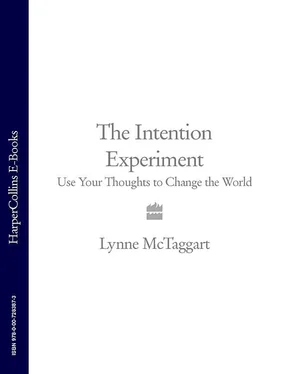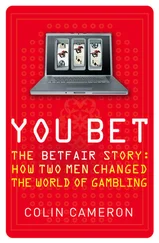19. K. Davis et al., ‘Bose-Einstein condensation in a gas of sodium atoms’, Physical Review Letters , 1995; 75: 3969–73.
20. M. W. Zwierlein et al., ‘Observation of Bose-Einstein condensation of molecules’, Physical Review Letters , 2003; 91: 250401.
21. H. Fröhlich, ‘Long range coherence and energy storage in biological systems’, Int. J. Quantum Chem ., 1968; II: 641–9.
22. For this entire example, see Tiller, Science and Human Transformation , op. cit.: 196.
23. M. Jibu et al., ‘Quantum optical coherence in cytoskeletal microtubules: implications for brain function’, Biosystems , 1994; 32: 195–209; S. R. Hameroff, ‘Cytoplasmic gel states and ordered water: possible roles in biological quantum coherence’, Proceedings of the 2nd Annual Advanced Water Sciences Symposium , Dallas, Texas, 1996.
CHAPTER THREE
CLEVE BACKSTER WAS AMONG THE FIRST to propose that plants are affected by human intention – a notion considered so preposterous that it was ridiculed for 40 years. Backster achieved his notoriety from a series of experiments that purported to demonstrate that living organisms read and respond to a person’s thoughts.
Plant telepathy interested me less than a tangential discovery of his that has been sidelined amid all his adverse publicity: evidence of a constant two-way flow of information between all living things. Every organism, from bacteria to human beings, appears to be in perpetual quantum communication. This relentless conversation offers a ready mechanism by which thoughts can have a physical effect.
This discovery resulted from a silly little diversion in 1966; Backster, at the time a tall, wiry man with a buzz cut and a great deal of childlike enthusiasm, was easily distracted. He often carried on working in his suite of offices when the rest of his staff had gone home and he could finally focus without the constant interruptions of colleagues and the tumultuous daytime activity of Times Square, four storeys below. 1
Backster had made his name as the country’s leading lie-detector expert. During the Second World War, he had been fascinated by the psychology of lying, and the use of hypnosis and ‘truth serum’ interrogation in counter-intelligence, and he had brought these twin fascinations to bear in refining the polygraph test to a high psychological art. He had launched his first programme with the CIA for counter-intelligence several years after the war, and then went on to found the Backster School of Lie Detection, still the world’s leading school teaching polygraph techniques some 50 years after it first opened its doors.
One morning in February, after working all night, Backster was taking a coffee break at 7 a.m. He was about to water the Dracaena and rubber plant in his office. As he filled up his watering can, he wondered if it might be possible to measure the length of time it would take water to travel up the stem of a plant from the roots and reach the leaves, particularly in the Dracaena , a cane plant with an especially long trunk. It occurred to him that he could test this by connecting the Dracaena to one of his polygraph machines; once the water reached the spot between the electrodes, the moisture would contaminate the circuit and be recorded as a drop in resistance.
A lie detector is sensitive to the slightest change in the electrical conductivity of skin, which is caused by increased activity of the sweat glands, which in turn are governed by the sympathetic nervous system. The polygraph galvanic skin response (GSR) portion of the test displays the amount of the skin’s electrical resistance, much as an electrician’s ohmmeter records the electrical resistance of a circuit. A lie detector also monitors changes in blood pressure, respiration, and the strength and rate of the pulse. Low levels of electrical conductivity indicate little stress and a state of calm. Higher electrodermal activity (EDA) readings indicate that the sympathetic nervous system, which is sensitive to stress or certain emotional states, is in overdrive – as would be the case when someone is lying. A polygraph reading can offer evidence of stress to the sympathetic nervous system even before the person being tested is consciously aware of it.
In 1966, the state-of-the-art technology consisted of a set of electrode plates, which were attached to two of a subject’s fingers, and through which a tiny current of electricity was passed. The smallest increases or decreases in electrical resistance were picked up by the plates and recorded on a paper chart, on which a pen traced a continuous, serrated line. When someone lied or in any way experienced a surge of emotion (such as excitement or fear), the size of the zigzag would dramatically increase and the tracing would move to the top of the chart.
Backster sandwiched one of the long, curved leaves of the Dracaena between the two sensor electrodes of a lie detector and encircled it with a rubber band. Once he watered the plant, what he expected to see was an upward trend in the ink tracing on the polygraph recording paper, corresponding to a drop in the leaf ’s electrical resistance as the moisture content increased. But as he poured in the water, the very opposite occurred. The first part of the tracing began heading downward and then displayed a short-term blip, similar to what happens when a person briefly experiences a fear of detection.
At the time Backster thought he was witnessing a human-style reaction, although he would later learn that the waxy insulation between the cells in plants causes an electrical discharge that mimics a human stress reaction on polygraph instruments. He decided that if the plant were indeed displaying an emotional reaction, he would have to come up with some major emotional stimulus to heighten this response.
When a person takes a polygraph test, the best way to determine if he is lying is to ask a direct and pointed question, so that any answer but the truth will cause an immediate, dramatic stress reaction in his sympathetic nervous system: ‘Was it you who fired the two bullets into Joe Smith?’
In order to elicit the equivalent of alarm in a plant, Backster knew he needed somehow to threaten its well-being. He tried immersing one of the plant’s leaves in a cup of coffee, but that did not cause any interesting reaction on the tracing – only a continuation of the downward trend. If this were the tracing of a human being, Backster would have concluded that the person being monitored was tired or bored. It was obvious to him that he needed to pose an immediate and genuine threat: he would get a match and burn the electroded leaf.
At the very moment he had that thought, the recording pen swung to the top of the polygraph chart and nearly jumped off. He had not burned the plant; he had only thought about doing so. According to his polygraph, the plant had perceived the thought as a direct threat and registered extreme alarm. He ran to his secretary’s desk in a neighbouring office for some matches. When he returned, the plant was still registering alarm on the polygraph. He lit a match and flickered it under one of the leaves. The pen continued on its wild, zigzag course. Backster then returned the matches to his secretary’s desk. The tracing calmed down and began to flat-line.
He hadn’t known what to make of it. He had long been drawn to hypnosis and ideas about the power of thought and the nature of consciousness. He had even performed a number of experiments with hypnosis during his work with the Army Counter Intelligence Corps and the CIA, as part of a campaign designed to detect the use of hypnosis techniques in Russian espionage.
But this was something altogether more extraordinary. This plant, it seemed, had read his thoughts . It wasn’t even as though he particularly liked plants. This only could have occurred if the plant possessed some sort of sophisticated extrasensory perception. The plant somehow must be attuned to its environment, able to receive far more than pure sensory information from water or light.
Читать дальше











